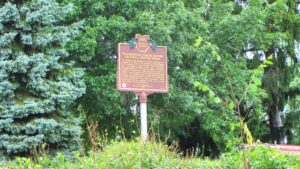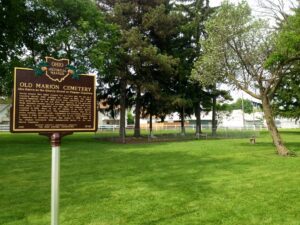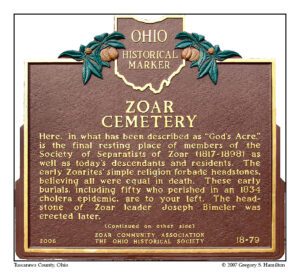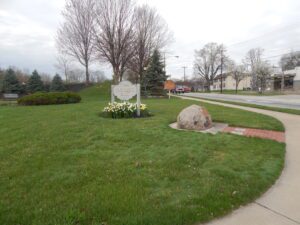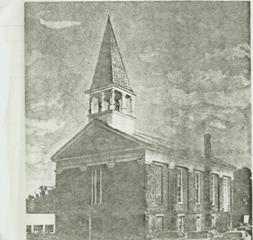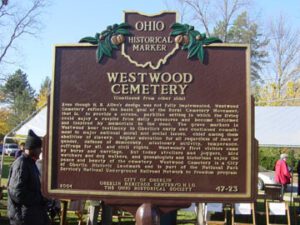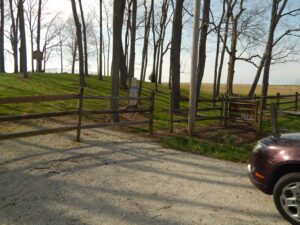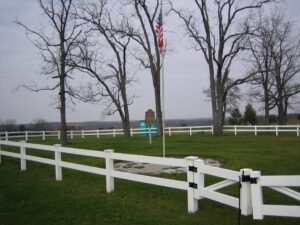, OH
The Marlborough Society of Friends Meeting was established in 1813 by the Salem Quarterly Meeting at the request of the Springfield (Damascus) Meeting. The Marlborough Friends and Lexington Friends combined to become the Alliance Friends in 1865 and relocated to 322 East Perry Street in Alliance, which was the site of a Methodist Episcopal Church. The Marlborough Friends Meeting House and the burying ground were sold to W.W. Holibaugh in 1897 and remain in private ownership. When State Route 619 was widened in 1941, some burials were exhumed and re-interred
, OH
Marion founder Eber Baker donated this two-acre plot for use as a cemetery shortly after platting the village in 1822. The oldest legible headstone bears an 1812 burial date, indicating that it may have been moved to the site after the opening of the cemetery. While complete records are not available, approximately 200 burials took place in the cemetery with the final one believed to have occurred in 1872. Many of the 65 victims of an 1854 cholera outbreak were buried here. The cemetery’s location next to an active railroad, combined with unfavorable soil conditions, eventually created a need for relocation. This led to the establishment of a cememtery on Delaware Avenue that opened in 1858. Many of the original internments were subsequently moved to the new Marion Cemetery.
, OH
Here, in what has been described as “God’s Acre,” is the final resting place of members of the Society of Separatists of Zoar (1817-1898) as well as today’s descendants and residents. The early Zoarites’ simple religion forbade headstones, believing all were equal in death. These early burials, including fifty who perished in an 1834 cholera epidemic, are to your left. The headstone of Zoar leader Joseph Bimeler was erected later. (continued on other side)
, OH
Trenton’s founder, Michael Pearce, came to the area in 1801. The original village of 33 lots was named Bloomfield. When the post office was established in 1820, it was named Trenton to honor the founder’s home state of New Jersey. Pearce’s son-in-law, Squier Littell, was the first resident doctor in Butler County. Originally settled by the English, Trenton saw a migration of Germans by 1840. By 1851, the farming community became a grain center with the introduction of the Cincinnati, Hamilton, and Dayton Railroad. Further development occurred when a franchise was granted to operate interurban electric traction cars through the village in 1896. Early commercial endeavors were Dietz, Good & Company grain elevator, Trenton Foundry, and Magnode Corporation. By 1991, the largest industries were Miller Brewing Company and Cinergy/Cincinnati Gas & Electric.
, OH
This site has long served the religious, education, and public interests of the residents of Mechanicsburg. A local Methodist congregation built its first church here in 1820, and the townspeople also used the structure as its village school. The Methodists replaced their original structure in 1837, using brick as the main building material. As the Methodist congregation grew, however, it was determined that a larger, more permanent structure was needed. As a result, the Mechanicsburg First Methodist Church was built here in 1858, and it served the congregation until 1894 when an African American based Second Baptist congregation purchased the building at a cost of $2,850. Besides religion and education, the site was also used as Mechanicsburg’s first cemetery. That cemetery lasted until the Maple Grove Cemetery was established and burials at this site were relocated there. [continued on other side]
, OH
Shortly after Oberlin Colony was established in 1833, a two-acre burying ground was set aside south of Plum Creek in the area bounded by Main, Morgan, and Professor streets. By 1861, however, with the town and Oberlin College growing and the Civil War escalating, the need for a larger cemetery became clear. After an extensive search, 27.5 acres of land belonging to Henry Safford were acquired one mile west of the center of Oberlin. H.B. Allen was hired to create a design in the style of the Rural Cemetery Movement, and in July 1864 Westwood Cemetery was formally dedicated. Burials in Westwood had actually begun in August 1863, and over the next few years hundreds of remains were reinterred from Oberlin’s “Old Cemetery” and from burying grounds in surrounding communities. In the mid-1860s the cemetery was enlarged to its present 47 acres, and in 2004 burials and memorials were estimated to number almost ten thousand. (Continued on other side)
, OH
In the early years of the nineteenth century, a religious unrest known as the Second Great Awakening spread across much of the American frontier. Among the most influential of the evolving religious organizations were the Campbellites, or Disciples of Christ, founded in the 1820s by Thomas and Alexander Campbell. The Campbellite movement sought to “restore” New Testament Christianity by calling for a return to the primitive church revealed in the gospels. Campbellites denied creeds and oath-taking and rejected sectarianism. They believed in baptism by immersion and communion on Sundays. Followers also dealt with problems and transgressions of members within the church and did not use civil courts. They held a millennial view that professed human happiness and the belief that Christ would reign on earth for a thousand years. Believers spread this word to the pioneers of the Doty Settlement and elsewhere. By 1850, there were ninety Campbellite Churches in Ohio.
, OH
A cemetery was established on the site in 1811 and became the final resting place for many of the area’s early pioneer families. The Hanover Township Trustees obtained title to the land in 1823 from John and Anna Farnsworth, and it was expanded for additional plots in 1879. Unfortunately many burials remain unmarked or can be located only by primitive limestone markers above them. The oldest readable headstone is dated 1816. (continued on the other side)


